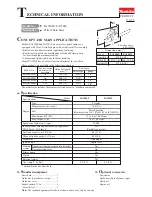
CUTTING AIDS AND ACCESSORIES
AUXILIARY MITER GAUGE
FACING
An auxiliary miter gauge facing is used to increase the surface
area of the miter gauge face.
The use of miter gauge with auxiliary facing is the same as
original miter gauge (without auxiliary facing). See Page 35 for
the use of miter gauge.
If desired, you can fit the miter gauge with an auxiliary wood
facing that should be at least 1-inch (25mm) higher than the
maximum depth of cut, and at least as wide as the miter
gauge.
This auxiliary wood facing can be fastened to the front of the
miter gauge by using (2) M6 or 1/4-20 flat head screws and
nuts, placing the nuts into the slots provided in the face of the
miter gauge body.
See Figure 34.
Make sure the screws are long enough to secure the facing.
FIGURE 34
Flat head screws must be recessed into face
of board.
PUSH BLOCK
1.
Select a piece of wood about 4-inches wide, 6-inches
long and 1- to 2-inches thick (a cutoff from a 2 by 4
makes a good blank for a push block).
2.
Drill a hole in the block and glue in a dowel to use as
a handle (you can angle the hole to provide a more
comfortable grip on the handle).
3.
Glue a piece of rough or soft material such as
sandpaper or rubber to the bottom of the block to grip
the workpiece (old mouse pads work well).
See Figure 35.
FIGURE 35
Wooden
dowel
Sandpaper or
old
mouse pad
material
Push blocks are blocks used to securely hold down the
workpiece against the table. They include some gripping
surface or handle to hold the block. Any screws running
through the underside of the block to fasten the handle should
be recessed in order to avoid contact with the workpiece.
GROOVING AND RABBETING
Clamping a featherboard in front of the blade can increase
safety during non-through cuts, like grooving and rabbeting,
and through cuts. Use a featherboard to guide the workpiece
against the table and fence when making non-through
cuts such as rabbeting. A featherboard helps to control the
kickback.
30
31
















































